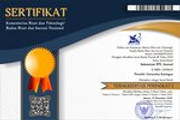TEACHER TALK IN YOUNG LEARNERS’ CLASSROOM INTERACTION
Abstract
In English Foreign Language (EFL) class, learners are not familiar with English in daily conversation, except several learners who have background in using English in their home or environment. Therefore, teacher plays a significant role as facilitator to introduce them into the language. This study aims to describe teacher talk and students talk as well as the way teacher talk is realized in young learners’ classroom interaction by applying a descriptive method. The fifth grade classroom interaction at a primary school in Majalengka was recorded as the sample of the analysis. The data gained through observation was in the form of transcribed interaction. Besides, interview was also used to collect the data. To analyze the data, this study employed Flanders Interaction Analyzed Categories. Upon analyzing the data, the following findings are identified; 1) Accepting feeings (2 occuraces); 2) Encouragement (17 occuraces); 3) Accepting or using ideas of learners (54 occuraces); 4) Asking questions (142 occuraces); 5) lecturing (49 occuraces); 6) Giving directions (53 occuraces); 7) Criticizing learners behaviour (9 occuraces); 8) Learners-response (151 occuraces); 9) Learners-initiation (7 occuraces); and 10) Period of silence or confusion (8 occuraces). Finally, the use of similar activity for too long will make young learners feel bored, therefore, teacher needs to provide variety and more meaningful activities. In this case, teacher can use various techniques to stimulate learners’ response. Besides, creating group discussion will give more opportunity to the learners to talk and learn from their peers.
Keywords: teaching speaking; teacher talk; students talk; young learners.
Full Text:
PDFReferences
Brown, H. D. (2001). Teaching by principle: An interactive approach to language pedagogy. London. Prentice Hall.
Cameron, L. (2001). Teaching languages to young learners. Cambridge: Cambridge University Press.
Creswell, J. W. (2012). Educational research: Planning, conducting and evaluating quantitative and qualitative research. New York: Pearson.
Ellis, R. (1986). Understanding second language acquisition. Oxford: Oxford University Press.
Husnaini. (2005). Teacher talk and learner talk in classroom interaction: An interaction analysis to an English language class at SMPN 29 Bandung. Unpublished Thesis. State Islamic University of Sunan Gunung Djati Bandung.
Nunan, D. (1989). Understanding language classroom: A guide for teacher initiated action. London: Prentice Hall International.
Paul, D. (2001). Teaching English to children in Asia. Longman Asia ELT.
Wood, D., & Wood, H. (1986). Teaching and talking with deaf children. London: John Wiley and Sons Ltd.
Xiou-yan. (2006). Teacher talk and EFL in university classroom. Retrieved from www.Asean-efl-journal.com/thesis_Ma_Xiou.pdf.
DOI: https://doi.org/10.25134/ieflj.v6i1.2651
Refbacks
- There are currently no refbacks.

This work is licensed under a Creative Commons Attribution-ShareAlike 4.0 International License.

